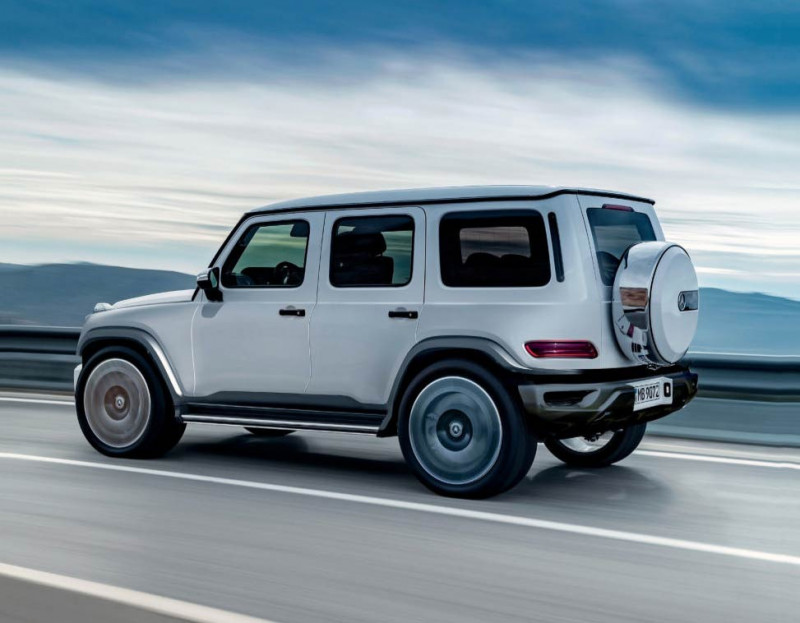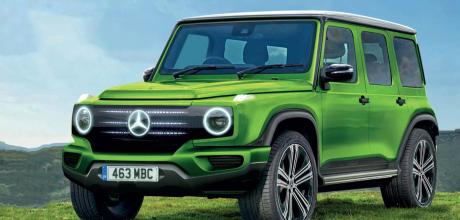2024 Mercedes-Benz EQG - secret tech flagship is the future of 4x4s
Mercedes primes electric G-Class Defender beater. Luxury EQG 4x4 will harness EQS battery and motors for supreme off-road capability.
HOW MERC’S G-CLASS WILL BE REBORN AS EV
Mercedes-Benz EQG Defender rival turns EV in 2024
Mercedes-Benz will preview the long-mooted electrification of its G-Class SUV with a concept at the Munich motor show that will spearhead the roll-out of a 4x4 sub-brand. It has been nearly two years since CEO Ola Källenius confirmed that the Magna-built Land Rover Defender rival – launched in 1979 as the G-Wagen – would gain an all-electric variant, also predicting that “the last Mercedes built will be a G-Class”.

A production version is due in 2024, by which point most of the mainstream models in the Mercedes line-up will be available with electric power. The Munich show car is expected to reveal how the G-Class will be restyled and reconfigured for the electric age, with design and interior cues that closely preview the final production model – much like how 2019’s Vision EQS concept proved a prelude to the new EQS luxury limousine.
Given how subtly the G-Class has evolved since its arrival 42 years ago, it is unlikely that Mercedes will reinvent its characteristically rugged two-box design, but a host of new styling cues that bring it into line with other EQ-badged models are expected.
BEV powertrains’ instant torque makes them ideal for off-roading
A new-shape, one-piece front grille will be the chief differentiator over the ICE-powered car, as is the case for the GLB-based EQB, but new wheel designs and light clusters and a revamped rear end will help to distinguish the EQG from the G-Class.
The EQG’s off-road potential was demonstrated in 2020 by the EQC 4x42 concept – an outlandish one-off reworking of Mercedes’ first bespoke EV, which served as a technical showcase for a family of new electric off-roaders that the firm will sell under its newly formed G sub-brand.

Raised suspension and chunky black lower-body trim were the obvious visual giveaways, but it was the ground clearance-enhancing portal axles (lifted from the jacked-up G500 4x42) and increased track widths that transformed the luxury-focused EQC into a capable off-roader and most heavily previewed the capabilities of the EQG.
Development engineer Jürgen Eberle acknowledged that there “remains great enthusiasm for traditional off-roaders” and said the EQC 4x42 showed that such cars can be “fully electric but with the ability to go off road in a serious way”, suggesting such a formula is high on the list of priorities for the EQG.
The high torque and instant acceleration provided by an electric powertrain make them ideal for off-road applications, meaning the EQG should stay true to the go-anywhere ethos of the G-Class, which has historically served in various forms with a number of international military forces.
It is thought that Mercedes bosses intended the GLB and its EQB sibling to be marketed as premium, family-friendly off-roaders, in a similar vein to the Land Rover Discovery Sport, but its A-Class-derived, front-wheel- drive MFA2 architecture is more overtly biased towards on-road operations.
As a dedicated off-roader, the EQG is unlikely to use the low-slung EVA architecture that will underpin all new bespoke EVs from Mercedes, instead using an electrified set-up based on the ladder-frame underpinnings from the G-Class.
Adaptations to the chassis will make room for a lithium ion battery pack under the floor, with the G-Class’s extended wheelbase potentially allowing for the 107.8kWh pack fitted to the top-rung EQS, which should allow for a competitive WLTP range – although one not as long as the extremely aerodynamically efficient saloon’s.
Mercedes has already trademarked the EQG 560 and EQG 580 names, which suggests that the off-road EV will be offered with the same 516bhp, 631lb ft twin-motor set-up as the top-rung version of the EQS, as well as a lesser-powered entry-level set-up.
Given the model’s focus on all-terrain ability, a rear-driven EQG 450 is unlikely, but rear-wheel steering, as fitted to its saloon sibling, would bolster the EQG’s off-road ability and in-town manoeuvrability.
All EQG variants are expected to maintain a premium focus, given that Mercedes will market G-badged models under the ‘Adventurous Luxury’ banner, meaning we won’t see the EQG offered in bare-bones, utilitarian specifications, as the G-Wagen was historically. Today’s G-Class starts at just over £100,000 in the UK, and the EQG is likely to follow existing EQ-badged models by commanding a small premium over its ICE-powered equivalent.
However, given the fundamental architectural similarities between the EQG and the G-Class, the premium is unlikely to be as stark as the difference between the EQS and largely unrelated S-Class.
Expect technological and design influence from other electric Mercedes models inside, where the EQG will feature the latest version of Mercedes’ MBUX infotainment platform through a large-format touchscreen, which will be twinned with an all-digital gauge cluster offering EV-specific displays. The G-Class, while not as strong a seller as Mercedes’ core A-Class, B-Class, C-Class and E-Class, is a key profit driver for the German firm. In 2016, the SUV sold more than 20,000 units for the first time. That pales in comparison to the 425,000 C-Classes sold, but the G-Class’s high list price makes it a consistently reliable revenue generator, and the introduction of the heavily modernised second-generation version in 2018 has served to ensure its longevity.
EQB has off-road style but is based on the A-Class. EQG will retain classic G shape, with only subtle nods to electrification.
RIVAL ELECTRIC OFF-ROADERS ON THE WAY
Ineos Grenadier FCEV Ineos Automotive’s first car will be available from launch with straight-six petrol and diesel engines supplied by BMW, but a new partnership with Hyundai, maker of the Nexo fuel-cell SUV, opens up the possibility for a future hydrogen variant. Ineos commercial director Mark Tennant told Autocar last year that a battery-electric Grenadier isn’t on the cards, because it wouldn’t make sense to take up a “usable payload with a battery pack” sufficiently sized to make an electrified Grenadier capable of venturing far off road. A time frame hasn’t been given by Ineos, but a Grenadier FCEV is unlikely to arrive until after 2023, following the ICE-powered 4x4’s 2022 market launch. Jeep Wrangler PHEV and BEV Jeep’s flagship model is more utilitarian in its ethos than its European rivals yet still fast approaching the electric era, with a plug-in hybrid variant arriving in the coming months as a precursor to a full BEV. The Wrangler 4xe matches a 2.0-litre four-cylinder turbo petrol engine with a pair of electric motors for totals of 370bhp and 470lb ft. This makes it considerably more powerful than the current UK-spec petrol car, while a 17kWh battery pack gives an EV range of 25 miles. Little is known about the planned Wrangler EV, but the one-off Magneto EV concept shown earlier this year features four individual battery packs and a claimed range of around 220 miles – as well as, uniquely for an EV, a six-speed manual gearbox. Land Rover Defender BEV and FCEV As part of JLR’s drastic transformation strategy, Land Rover will launch six BEVs in the next five years, with the Defender among the models tipped for conversion. Two new platforms will be used: EMA for the Discovery Sport and Range Rover Evoque, and MLA for the larger Range Rover and Range Rover Sport. It is not confirmed which the Defender BEV will use, and Land Rover has yet to reveal which model will be the basis for its first BEV, due in 2024. Meanwhile, Land Rover is soon to begin trials of a fuel-cell Defender as part of its Project Zeus hydrogen research programme. It says this powertrain provides optimum performance in extreme conditions and faster refuelling times.
PROOF OF CONCEPT ALREADY EXISTS
Austrian battery specialist Kreisel turned its hand to the G-Class back in 2017 to create a one-off, 186-mile electric 4x4 developed in partnership with actor Arnold Schwarzenegger. Based on the first-generation G350d diesel, Kreisel’s electric G-Class featured an 80kWh battery pack, weighing 510kg, split between its emptied engine bay and fuel tank cavity. Power was supplied by “several” electric motors that produced a combined 483bhp for a 0-62mph time of around 5.6sec and a top speed of 114mph – figures that are likely to be almost replicated by the similarly conceived EQG. Kreisel’s G-Class EV remains to this day a one-off, and the company hasn’t given the same treatment to the second-generation G-Class, but it serves to indicate how readily the G-Class can be converted to battery-electric power.
EQC 4x42 concept showed ability of BEV off-roaders. Mk2 G-Class offers petrol and diesel straight sixes.


